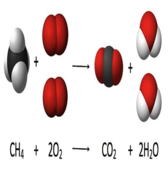 | ||||
Chemical Bonds & Reactions
Practice Test Questions
Virtual Cell Biology Classroom of Science Prof Online
Chemical Bonds & Reactions Sample Test Qus
 | ||||
Free review questions to help
students better understand
 | ||||||
SPO VIRTUAL CLASSROOMS
The following questions, from the Virtual Cell Biology Classroom, are designed to help students better understand Inorganic Chemistry. All questions are based on materials that can be found on the Chemical Bonds & Reactions Lecture Main Page.
2. The type of chemical bond that results from the sharing of electrons is:
a. ionic
b. covalent
c. decomposition
d. hydrogen
3. Which is the result of the physical combination of two substances?
a. molecule b. mixture c. solute d. compound
4. Which statement is NOT true regarding ions?
a. Ions occur when chemical substances dissociate in water.
b. Ions can have a positive or negative charge.
c. Ions are neutral.
d. Ions are called cations or anions, depending on their charge.
e. Ions are released by acids and bases.
5. Which is simplest?
a. molecule b. atom c. elephant
d. compound e. synthesis
6. A chemical bond in which electrons are transferred from one atom to another is:
a. ionic b. covalent c. decomposition d. hydrogen
1. The surface tension of water is based primarily on what type of bonds?
a. covalent
b. hydrogen
c. ionic
d. U.S. Government e. peptide
Page last updated:
5/2016
7. What is the difference between between a polar and non-polar covalent bond?
a. Polar is cold and non-polar is warm.
b. Polar is negative and non-polar is positive.
c. Polar is an unequal sharing of electrons, non-polar is an equal sharing of electrons.
d. Polar is an equal sharing of electrons, non-polar is an unequal sharing of electrons.
e. Polar is an unequal sharing of protons, non-polar is an equal sharing of protons.
8. If an atom loses an electron, it has been...
a. oxidized b. reduced
c. changed to another element d. neutralized
9. This is the chemical formula for three molecules of Aluminum Sulfate, 3Al2(SO4)3. How many total atoms of oxygen are present?
a. 3 b. 36 c. 12 d. 7 e. 72
10. Is this chemical equation balanced?
3C6H12O6 ⇒ 9CO2 + 9H2O
a. yes b. no c. cannot be determined d. only on the left
You have free access to a large collection of materials used in a college-level introductory Cell Biology Course. The Virtual Cell Biology Classroom provides a wide range of free educational resources including Power Point Lectures, Study Guides, Review Questions and Practice Test Questions.
You have FREE access to a large collection of materials used in a college-level introductory biology course. The Virtual Biology Classroom provides a wide range of free educational resources including PowerPoint Lectures, Study Guides, Review Questions & Practice Test Questions.





